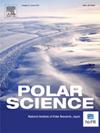Ice thickness inversion assessment: A comparison study for Waldemarbreen and Irenebreen glaciers, Svalbard
IF 2
4区 地球科学
Q3 ECOLOGY
引用次数: 0
Abstract
Accurate ice thickness estimates are crucial for solving both glaciological and hydrological problems, and ice thickness inversion models are generally used to obtain these estimates. Several studies have assessed the accuracy of model inversions, however, usually the evaluation is done against a sparse set of field measurements. In this study, we employ the open-source models GlabTop2 and Open Global Glacier Model (OGGM) to estimate ice thickness and volume for the Waldemarbreen and Irenebreen glaciers (Svalbard archipelago), evaluating their accuracy against ground-penetrating radar (GPR) measurements. The results show that the ice thickness root-mean-square errors for GlabTop2 and OGGM are 28.5 and 13.9 m and the relative volume errors are 17.4 and 39.9%, respectively. Calibration of glacier shape factor slightly improves GlabTop2 results, however, this model tends to provide good average estimates but falls short on accurate spatial thickness distribution. On the contrary, the OGGM model is highly dependent on the chosen dataset for mass balance calibration and tends to provide better spatial distribution while performing worse regarding average thickness and overall glacier volume. Both inversion models present severe thickness errors among studied glaciers, implying the need for improvements in models and underlying theoretical assumptions that require continuous and extensive field measurements.
冰厚反演评价:斯瓦尔巴群岛Waldemarbreen和Irenebreen冰川的比较研究
准确的冰厚估算对于解决冰川学和水文问题至关重要,通常使用冰厚反演模型来获得这些估算。一些研究已经评估了模型反演的准确性,然而,通常评估是针对稀疏的现场测量集进行的。在这项研究中,我们使用开源模型GlabTop2和开放全球冰川模型(OGGM)来估计瓦尔德马布林和Irenebreen冰川(斯瓦尔巴群岛)的冰厚和体积,并评估它们在探地雷达(GPR)测量下的精度。结果表明,GlabTop2和OGGM的冰厚均方根误差分别为28.5和13.9 m,相对体积误差分别为17.4和39.9%。冰川形状因子的校正略微改善了GlabTop2模型的结果,但该模型往往提供良好的平均估计,但在精确的空间厚度分布方面存在不足。相反,OGGM模型高度依赖于所选择的数据集进行质量平衡校准,并且倾向于提供更好的空间分布,而在平均厚度和总体冰川体积方面表现较差。这两种反演模式在所研究的冰川中都存在严重的厚度误差,这意味着需要改进模式和基础的理论假设,这些假设需要连续和广泛的实地测量。
本文章由计算机程序翻译,如有差异,请以英文原文为准。
求助全文
约1分钟内获得全文
求助全文
来源期刊

Polar Science
ECOLOGY-GEOSCIENCES, MULTIDISCIPLINARY
CiteScore
3.90
自引率
5.60%
发文量
46
期刊介绍:
Polar Science is an international, peer-reviewed quarterly journal. It is dedicated to publishing original research articles for sciences relating to the polar regions of the Earth and other planets. Polar Science aims to cover 15 disciplines which are listed below; they cover most aspects of physical sciences, geosciences and life sciences, together with engineering and social sciences. Articles should attract the interest of broad polar science communities, and not be limited to the interests of those who work under specific research subjects. Polar Science also has an Open Archive whereby published articles are made freely available from ScienceDirect after an embargo period of 24 months from the date of publication.
- Space and upper atmosphere physics
- Atmospheric science/climatology
- Glaciology
- Oceanography/sea ice studies
- Geology/petrology
- Solid earth geophysics/seismology
- Marine Earth science
- Geomorphology/Cenozoic-Quaternary geology
- Meteoritics
- Terrestrial biology
- Marine biology
- Animal ecology
- Environment
- Polar Engineering
- Humanities and social sciences.
 求助内容:
求助内容: 应助结果提醒方式:
应助结果提醒方式:


